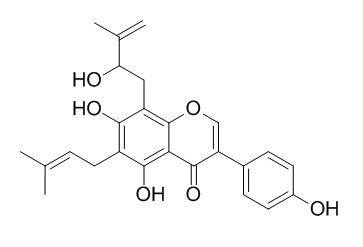Erysenegalensein E
Standard reference
Inquire / Order:
manager@chemfaces.com
Technical Inquiries:
service@chemfaces.com
Tel:
+86-27-84237783
Fax:
+86-27-84254680
Address:
1 Building, No. 83, CheCheng Rd., Wuhan Economic and Technological Development Zone, Wuhan, Hubei 430056, PRC
Providing storage is as stated on the product vial and the vial is kept tightly sealed, the product can be stored for up to
24 months(2-8C).
Wherever possible, you should prepare and use solutions on the same day. However, if you need to make up stock solutions in advance, we recommend that you store the solution as aliquots in tightly sealed vials at -20C. Generally, these will be useable for up to two weeks. Before use, and prior to opening the vial we recommend that you allow your product to equilibrate to room temperature for at least 1 hour.
Need more advice on solubility, usage and handling? Please email to: service@chemfaces.com
The packaging of the product may have turned upside down during transportation, resulting in the natural compounds adhering to the neck or cap of the vial. take the vial out of its packaging and gently shake to let the compounds fall to the bottom of the vial. for liquid products, centrifuge at 200-500 RPM to gather the liquid at the bottom of the vial. try to avoid loss or contamination during handling.
Br J Pharmacol.2024, 181(24):5009-5027.
Fitoterapia.2024, 175:105955.
Appl. Sci.2022, 12(4), 2032.
J Chromatogr B Analyt Technol Biomed Life Sci.2019, 1126-1127:121743
Pak J Pharm Sci.2019, 32(6):2879-2885
Journal of Third Military Medical University2018, 40(12):1073-1078
J Med Food.2024, 27(8):728-739.
Molecules.2019, 24(22):E4022
Molecules.2023, 28(10):4121.
Front Neurosci.2019, 13:1091
Related and Featured Products
Phytochemistry. 2001 Dec;58(7):1113-20.
Cytotoxic isoflavones from Erythrina indica.[Pubmed:
11730876]
METHODS AND RESULTS:
Bioassay-directed fractionation of the CH(2)Cl(2)-MeOH (1:1) extract of the stem bark of Erythrina indica, has resulted in the isolation of two new isoflavone derivatives named indicanines D and E together with 11 known compounds including: six isoflavones (genistein, wighteone, alpinumisoflavone, dimethylalpinumisoflavone, 8-prenyl erythrinin C, and Erysenegalensein E), one cinnamate (erythrinassinate B), two pentacyclic triterpenes (oleanolic acid and erythrodiol), and two phytosterols (stigmasterol and its 3-O-beta-D-glucopyranoside).
CONCLUSIONS:
The structures of the new compounds were elucidated by means of spectroscopic analysis. The in vitro cytocidal activity against KB cells of some of the isolated compounds is also reported.
Phytochemistry, 1999 , 52 (1) :87-94.
Six diprenylisoflavones, derrisisoflavones A–F, from Derris scandens.[Reference:
WebLink]
Chromatographic separation of EtOH extracts of the stems of Derris scandens has yielded six new diprenylisoflavones, named derrisisoflavones A–F, together with six known isoflavones.
METHODS AND RESULTS:
Their structures were elucidated by spectroscopic analyses. The known compounds were lupalbigenin, scandinone, Erysenegalensein E, lupinisol A, lupinisoflavone G and 5, 7,4′trihydroxy-6, 8-diprenylisoflavone. Anti-dermatophyte activity of the isolated isoflavones from D. scandens against Trichophyton mentagrophytes was also examined.



